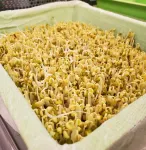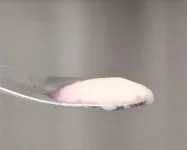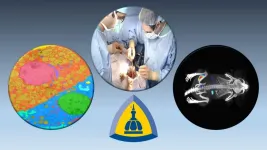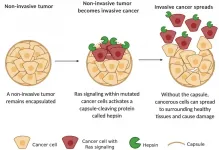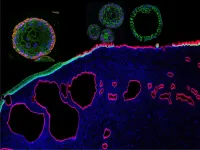(Press-News.org) Scleroderma, a chronic and currently incurable orphan disease where tissue injury causes potentially lethal skin and lung scarring, remains poorly understood.
However, the defining characteristic of systemic sclerosis, the most serious form of scleroderma, is irreversible and progressive scarring that affects the skin and internal organs.
Published in iScience, Michigan Medicine's Scleroderma Program and the rheumatology and dermatology departments partnered with the Northwestern Scleroderma Program in Chicago and Mayo Clinic to investigate the causes of disabling scarring, using human patient samples, preclinical mouse models and explanted human skin.
"We found that scleroderma inflammation dramatically increases CD38, an enzyme that normally breaks down a metabolic nutrient, NAD+. When NAD+ levels decrease, tissue injury becomes chronic and progresses to scar formation rather than to healthy repair," says study author John Varga, M.D., division chief of rheumatology at Michigan Medicine.
According to the study, treatments that prevented NAD+ reduction in the mice, whether by boosting the levels of the nutrient genetically or pharmacologically, prevented scarring in the skin, lungs and abdominal wall.
"This is one of the first studies to find a relationship between CD38 and scleroderma, as well as the linking between inflammation and metabolism to skin and organ scarring," says study author Johann Gudjonsson, M.D. Ph.D., a dermatologist at Michigan Medicine.
Boosting NAD+ via the precursor nicotinamide riboside, a safe and inexpensive dietary supplement, prevented skin and other organ scarring, providing the researchers a previously undiscovered pathogenic role of CD38 in scleroderma scarring.
"These results open the door to entirely novel treatments for fibrosis and scleroderma. Using precision medicine, these treatments could be selectively targeted to block CD38 in scleroderma patients who have elevated CD38," says study author Bo Shi, Ph.D., a research assistant professor of dermatology at Northwestern Medicine.
The research findings also create possibilities for restoring levels of NAD+ using pre-existing drugs, or well tolerated dietary supplements. Both of these therapeutic approaches are entirely novel strategies to halt scleroderma's most debilitating side effect.
Now, Varga looks forward to learning more about these testable approaches to treating scleroderma using safe, inexpensive agents in the Michigan Medicine Scleroderma Program, one of the preeminent integrated clinical and research programs for the diagnosis, prevention and cure of systemic sclerosis in the nation.
"We've defined a pathway that for the first time mechanistically links inflammation and metabolism to scarring in system sclerosis. These results provide a major advancement in unraveling the complexities of the disease, which is chronic, progressive and potentially deadly for many affected," says Varga.
"Now, we will look at designing and executing an early-stage 'proof of principle' clinical trial to assess the safety, tolerability and efficacy of such innovative treatments in patients."
Paper Cited: "Targeting CD38-dependent NAD+ metabolism to mitigate multiple organ fibrosis," iScience. DOI: 10.1016/j.isci.2020.101902
Like Podcasts? Add the Michigan Medicine News Break on iTunes, Google Podcast or anywhere you listen to podcasts.
New research finds connection: Inflammation, metabolism and scleroderma scarring
Study finds NAD+ break down leads to multi organ scarring, providing now a previously undiscovered pathogenic role of the enzyme CD38 in disease scarring.
2021-01-19
ELSE PRESS RELEASES FROM THIS DATE:
Scientists reveal structure of plants' energy generators
2021-01-19
Researchers have revealed the first atomic structures of the respiratory apparatus that plants use to generate energy, according to a study published today in eLife.
The 3D structures of these large protein assemblies - the first described for any plant species - are a step towards being able to develop improved herbicides that target plant respiration. They could also aid the development of more effective pesticides, which target the pest's metabolism while avoiding harm to crops.
Most organisms use respiration to harvest energy from food. Plants use photosynthesis to convert sunlight into sugars, and then respiration to break down the sugars into energy. This involves tiny cell components called mitochondria and a set of five protein assemblies ...
Set clear rules for vaccinating health care workers against SARS-CoV-2
2021-01-19
Provincial and territorial governments should set clear rules for vaccinating health care workers against SARS-CoV-2, the virus that causes COVID-19, in public and private settings, and should not leave this task to employers, according to an analysis in CMAJ (Canadian Medical Association Journal).
"An effective vaccine provided to health care workers will protect both the health workforce and patients, reducing the overall burden of COVID-19 on services and ensuring adequate personnel to administer to people's health needs through the pandemic," writes Dr. Colleen M. Flood, University of Ottawa Research Chair in Health Law & Policy and a ...
Canadian researchers create new form of cultivated meat
2021-01-19
HAMILTON, ON, Jan. 19, 2021 -- McMaster researchers have developed a new form of cultivated meat using a method that promises more natural flavour and texture than other alternatives to traditional meat from animals.
Researchers Ravi Selvaganapathy and Alireza Shahin-Shamsabadi, both of the university's School of Biomedical Engineering, have devised a way to make meat by stacking thin sheets of cultivated muscle and fat cells grown together in a lab setting. The technique is adapted from a method used to grow tissue for human transplants.
The sheets of living cells, each about the thickness of a sheet of printer paper, are first grown in culture and then concentrated on growth plates before being peeled ...
Research news tip sheet: Story ideas from Johns Hopkins Medicine
2021-01-19
NANOTECHNOLOGY PREVENTS PREMATURE BIRTH IN MOUSE STUDIES
Media Contact: Rachel Butch, rbutch1@jhmi.edu
In a study in mice and human cells, Johns Hopkins Medicine researchers say that they have developed a tiny, yet effective method for preventing premature birth. The vaginally delivered treatment contains nanosized (billionth of a meter) particles of drugs that easily penetrate the vaginal wall to reach the uterine muscles and prevent them from contracting. If proven effective in humans, the treatment could be one of the only clinical options available to prevent ...
Cyber-evolution: How computer science is harnessing the power of Darwinian transformation
2021-01-19
From a pair of simple principles of evolution--chance mutation and natural selection--nature has constructed an almost unfathomable richness of life around us. Despite our scientific sophistication, human design and engineering have struggled to emulate nature's techniques and her inexhaustible inventiveness. But that may be changing.
In a new perspective article, Stephanie Forrest and Risto Miikkulainen explore a domain known as evolutionary computation (EC), in which aspects of Darwinian evolution are simulated in computer systems.
The study highlights the progress our machines have made in replicating evolutionary processes and what this could mean for engineering design, software refinement, gaming strategy, robotics and even medicine, while fostering a deeper insight ...
What the lungfishes' genome teaches us about the vertebrates' conquest of land
2021-01-19
Using cutting-edge DNA sequencing technologies, a group of laboratories in Konstanz, Würzburg, Hamburg and Vienna, led by evolutionary biologist Professor Axel Meyer from the University of Konstanz, succeeded in fully sequencing the genome of the Australian lungfish. The genome, with a total size of more than 43 billion DNA building blocks, is nearly 14 times larger than that of humans and the largest animal genome sequenced to date. Its analysis provides valuable insights into the genetic and developmental evolutionary innovations that made it possible for fish to colonize land. The findings, published online in the journal Nature, expand our understanding of this major evolutionary ...
A master cancer gene hijacks a 'molecular crowbar' to make breast cancer cells invasive
2021-01-19
Researchers at the University of Helsinki have defined a cancer invasion machinery, which is orchestrated by a frequently mutated cancer gene called Ras. When signaling from Ras protein becomes abnormally high, like it does in many cancers, this switches on the cellular machinery that helps the cancer cells to depart from the tissue from which the cells have developed.
It has been unclear how the cancer invasion machinery works exactly, until now, as the study finds Ras in the role of Friar Lawrence in Shakespeare's famous play, "Get me an iron crow and bring it straight unto my cell (Romeo and Juliet, 5.2.21-23)." ...
No insect crisis in the Arctic - yet
2021-01-19
Climate change is more pronounced in the Arctic than anywhere else on the planet, raising concerns about the ability of wildlife to cope with the new conditions. A new study shows that rare insects are declining, suggesting that climatic changes may favour common species.
As part of a new volume of studies on the global insect decline, researchers are presenting the first Arctic insect population trends from a 24-year monitoring record of standardized insect abundance data from North-East Greenland.
The work took place during 1996-2018 as part of the ecosystem-based monitoring program Greenland Ecosystem Monitoring at the field station Zackenberg, located in the world's largest national ...
Novel organoid models: Illuminating path to cervical cancers
2021-01-19
Organoids are increasingly being used in biomedical research. These are organ-like structures created in the laboratory that are only a few millimetres in size. Organoids can be used to study life processes and the effect of drugs. Because they closely resemble real organs, they offer several advantages over other cell cultures.
Now there are also organoid models developed for the cervix. This part of the female body is particularly at risk to develop cancers. By creating novel organoid models, a group led by Cindrilla Chumduri (Würzburg), Rajendra Kumar Gurumurthy (Berlin) and Thomas F. Meyer ...
NIH officials highlight COVID-19 vaccine facts, unknowns for healthcare providers
2021-01-19
WHAT:
Healthcare providers must be able to explain the latest data supporting the safety and efficacy of vaccines for coronavirus disease 2019 (COVID-19) so they can strongly encourage vaccination when appropriate while acknowledging that uncertainty and unknowns remain. This message comes from a new commentary co-authored by Anthony S. Fauci, M.D., director of the National Institute of Allergy and Infectious Diseases (NIAID), part of the National Institutes of Health, and other leading NIAID scientists in the journal Annals of Internal Medicine.
The commentary provides an overview of the seven COVID-19 vaccines furthest along in development in the United States. For each vaccine candidate, the authors describe ...
LAST 30 PRESS RELEASES:
Manta rays create mobile ecosystems, study finds
Study: Mixed results in using lipoic acid to treat progressive multiple sclerosis
Norbert Holtkamp appointed director of Fermi National Accelerator Laboratory
New agentic AI platform accelerates advanced optics design
Biologists discover neurons use physical signals — not electricity — to stabilize communication
Researchers discover that a hormone can access the brain by hitchhiking
University of Oklahoma researcher awarded funding to pursue AI-powered material design
Exploring how the visual system recovers following injury
Support for parents with infants at pediatric check-ups leads to better reading and math skills in elementary school
Kids’ behavioral health is a growing share of family health costs
Day & night: Cancer disrupts the brain’s natural rhythm
COVID-19 vaccination significantly reduces risk to pregnant women and baby
The role of vaccination in maternal and perinatal outcomes associated with COVID-19 in pregnancy
Mayo Clinic smartwatch system helps parents shorten and defuse children's severe tantrums early
Behavioral health spending spikes to 40% of all children’s health expenditures, nearly doubling in a decade
Digital cognitive behavioral treatment for generalized anxiety disorder
Expenditures for pediatric behavioral health care over time and estimated family financial burden
Air conditioning in nursing homes and mortality during extreme heat
The Alps to lose a record number of glaciers in the next decade
What makes a good proton conductor?
New science reporting guide published for journalists in Bulgaria
New international study reveals major survival gaps among children with cancer
New science reporting guide published for journalists in Turkey
Scientists develop a smarter mRNA therapy that knows which cells to target
Neuroanatomy-informed brain–machine hybrid intelligence for robust acoustic target detection
Eight SwRI hydrogen projects funded by ENERGYWERX
The Lundquist Institute and its start-up company Vitalex Biosciences Announces Strategic Advancement of Second-Generation fungal Vaccine VXV-01 through Phase 1 Trials under $40 Million Competitive Con
Fine particles in pollution are associated with early signs of autoimmune disease
Review article | Towards a Global Ground-Based Earth Observatory (GGBEO): Leveraging existing systems and networks
Penn and UMich create world’s smallest programmable, autonomous robots
[Press-News.org] New research finds connection: Inflammation, metabolism and scleroderma scarringStudy finds NAD+ break down leads to multi organ scarring, providing now a previously undiscovered pathogenic role of the enzyme CD38 in disease scarring.
